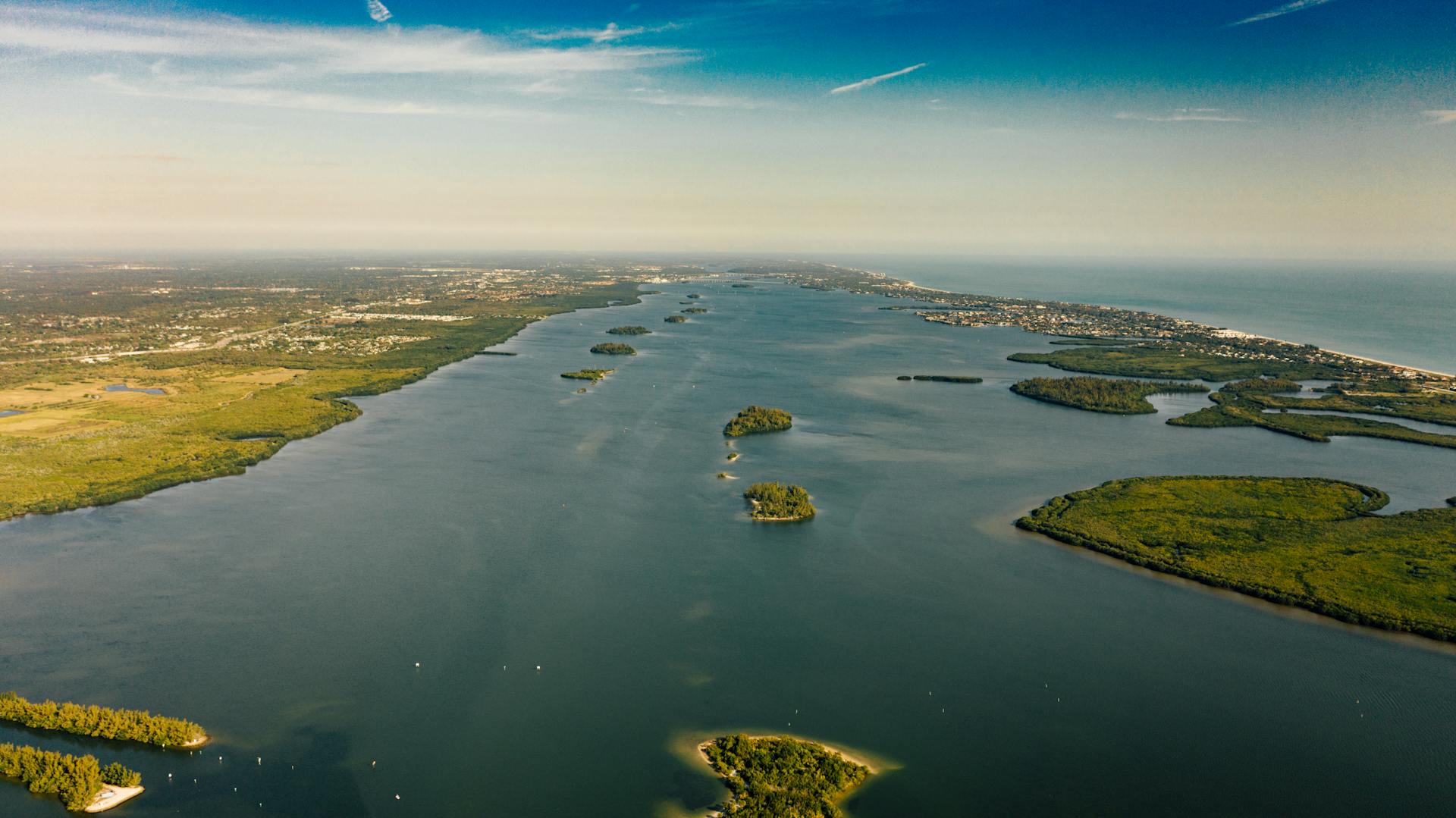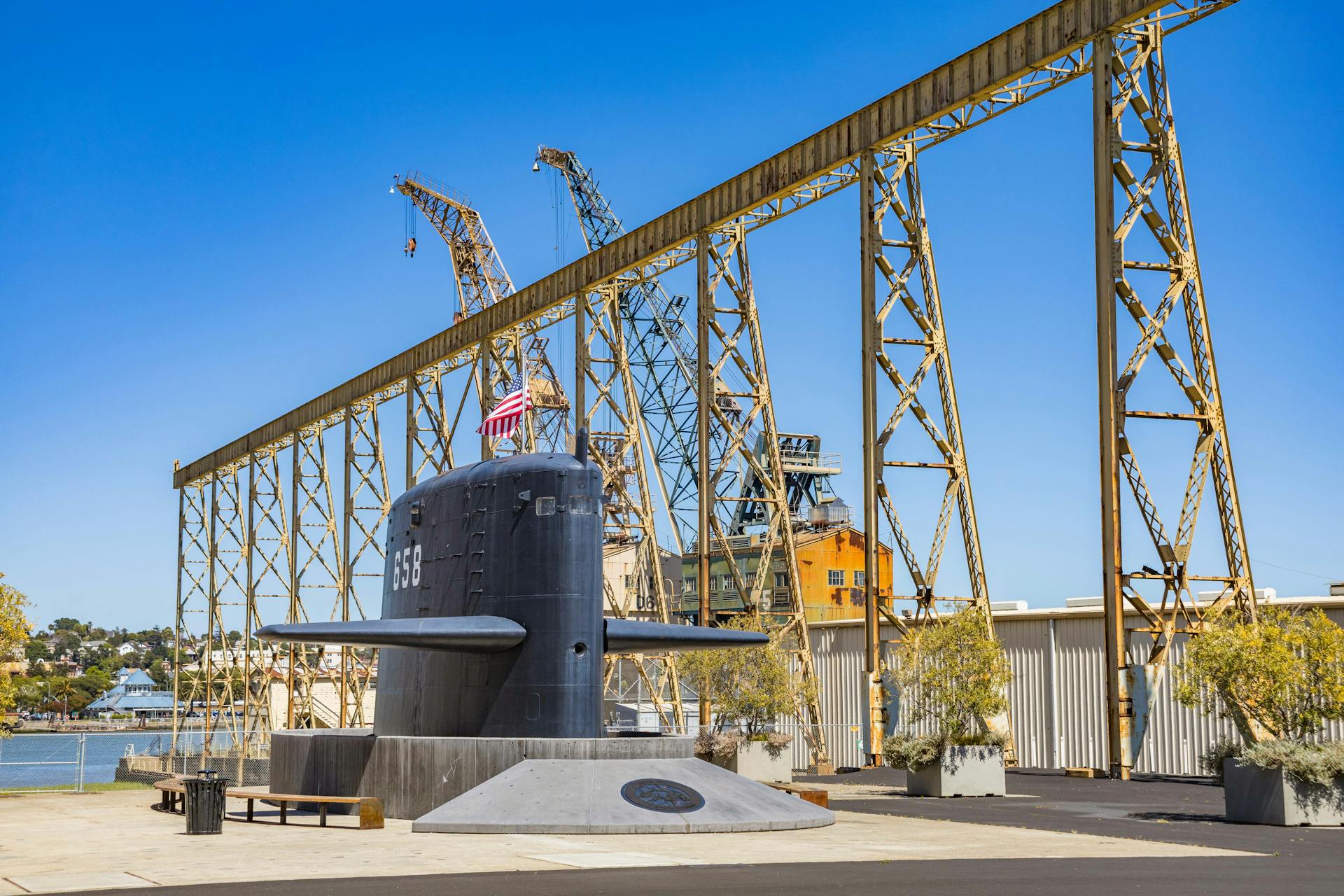
Mare Island Naval Shipyard played a significant role in the US war efforts during World War II, with the shipyard producing over 100 ships between 1940 and 1945.
The shipyard's production capacity was increased to meet the growing demand for warships, with the construction of new dry docks and the expansion of existing facilities.
Mare Island Naval Shipyard's war efforts were not limited to shipbuilding, as it also served as a repair and maintenance facility for ships and submarines.
The shipyard's legacy extends beyond its war efforts, as it also played a significant role in the development of the US Navy's nuclear submarine program.
Additional reading: List of Ships Built by William Denny and Brothers
History
Mare Island Naval Shipyard has a rich history that spans over a century and a half. Founded in 1854 in California, it was the first established Navy shipyard along the Pacific Ocean, according to the National Register of Historic Places.
The shipyard began building warships shortly after opening, including two of the Navy's first submarines, the USS Grampus and the USS Pike. These early submarines were a significant milestone in the development of naval technology.
For more insights, see: Polish Navy Shipyard
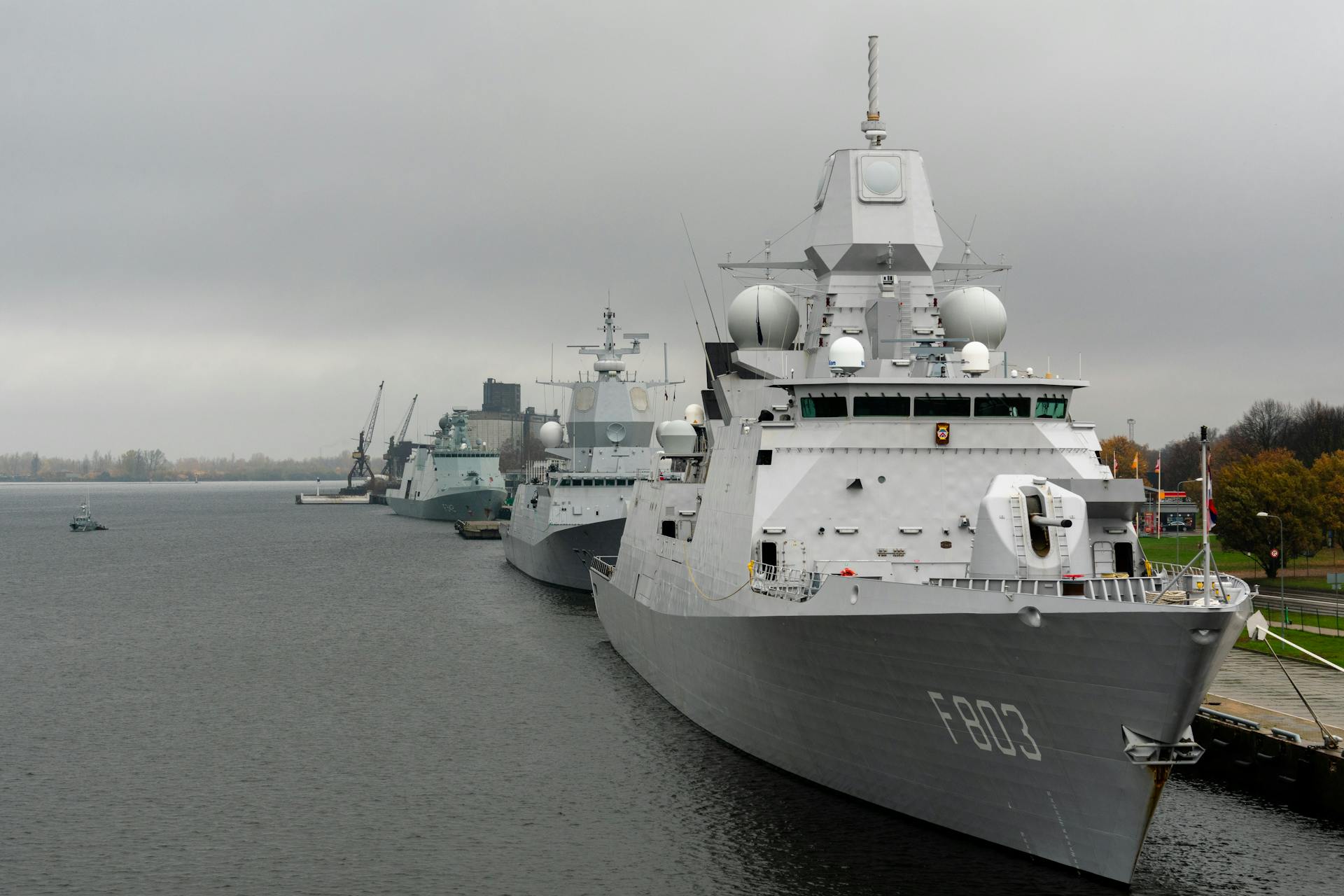
Naval ship production increased at Mare Island at the beginning of World War I, with the shipyard setting a speed record for building the destroyer USS Ward in 1918 in less than 18 days. This record still stands today as a testament to the shipyard's efficiency.
During World War II, MINSY saw its biggest business boom, building four submarine tenders, thirty-one destroyer escorts, seventeen submarines, thirty-three small craft ships, and around 300 landing craft vessels. This was one of the most significant periods of production in the shipyard's history.
Here's a breakdown of the types of vessels built during World War II:
- Four submarine tenders
- Thirty-one destroyer escorts
- Seventeen submarines
- Thirty-three small craft ships
- Around 300 landing craft vessels
After World War II, MINSY became one of the main shipyards for constructing and repairing the Navy's Pacific fleet of submarines. This was primarily because of the many submarines the shipyard built for the war.
Mare Island produced its first nuclear-powered submarine in 1957, marking a significant milestone in the development of nuclear-powered vessels.
Shipbuilding and Repair
Mare Island Naval Shipyard was a major player in the shipbuilding industry, with its construction of 175 ships during World War II.
The shipyard's repair facilities were also in high demand, with the yard completing over 300 major repairs and 1,000 minor repairs between 1940 and 1945.
The shipyard's ability to repair ships quickly and efficiently was crucial to the war effort, with some repairs completed in as little as 24 hours.
The shipyard's repair facilities included a dry dock that could accommodate ships up to 1,000 feet in length.
Mare Island Naval Shipyard was also a hub for submarine repair, with a special submarine repair facility on site.
The shipyard's expertise in submarine repair was likely due to the fact that it was home to the Mare Island Naval Shipyard's Submarine Division.
The shipyard's repair facilities were not limited to just ships, with the yard also repairing aircraft and other naval equipment.
Mare Island Naval Shipyard's shipbuilding and repair capabilities made it a vital part of the US Navy's operations during World War II.
You might like: Gadani Ship Breaking Yard
Pacific Fleet and Reserve
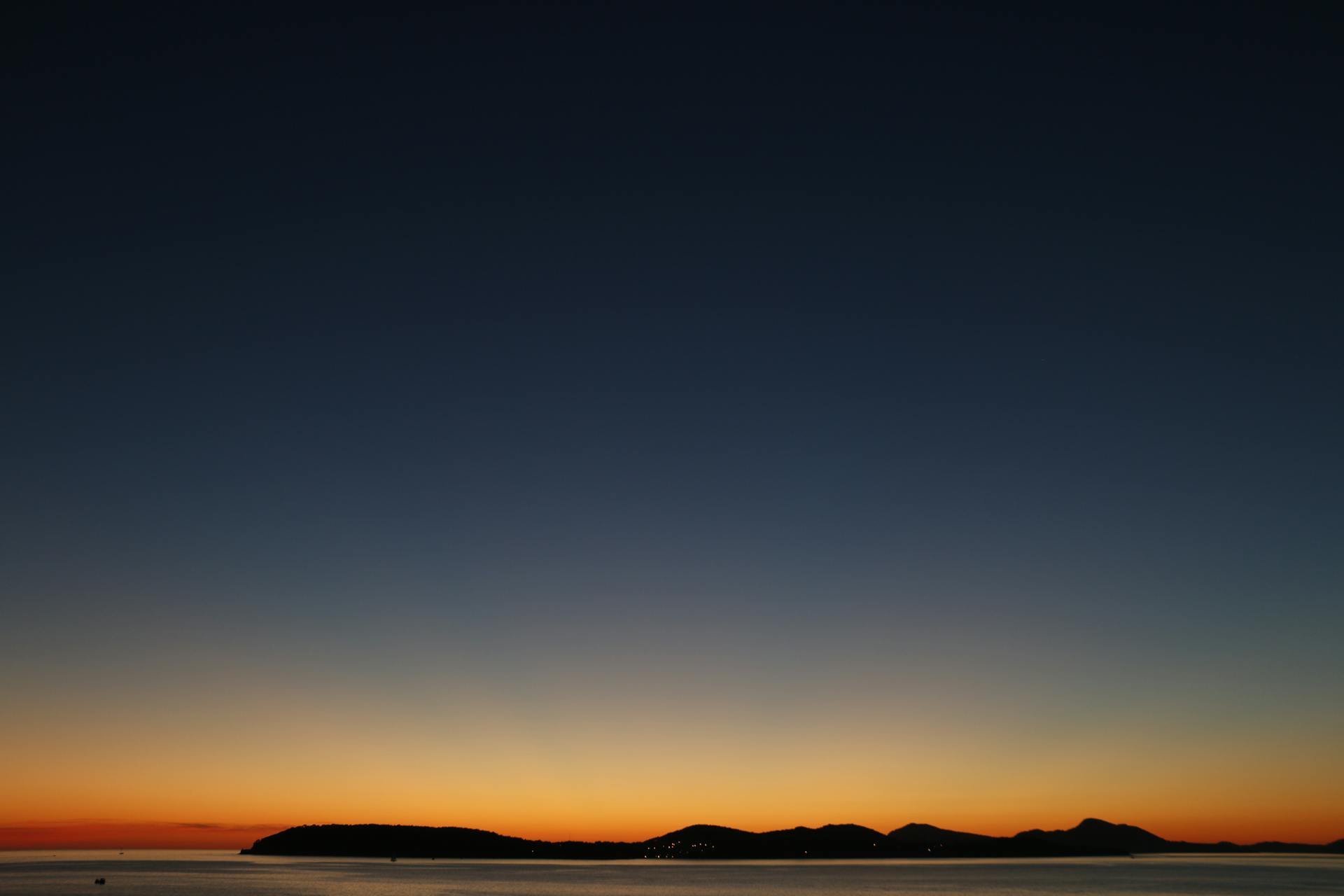
The Pacific Fleet and Reserve played a significant role at Mare Island Naval Shipyard. The Pacific Reserve Fleet, Mare Island was a large US reserve fleet that opened in 1946 to store surplus ships after World War II.
Some of these ships were reactivated for the Korean War and Vietnam War. The Reserve Fleet closed in 1996 with the shipyard, and the ships were scrapped or moved to other reserve fleets.
During World War II, Mare Island Naval Shipyard was at its peak capacity, employing up to 50,000 workers who worked on shipbuilding, repair, overhaul, and maintenance of various seagoing vessels, including surface combatants and submarines.
A unique perspective: Neelam Pacific Market San Bruno Ca
World War II
During World War II, Mare Island Naval Shipyard (MINSY) played a crucial role in the Pacific Fleet's efforts. Up to 50,000 workers were employed at the shipyard.
The shipyard's facilities were expanded to support the war effort, with a usable area increasing from 635 acres to over 1500 acres by 1945. Most of the large permanent buildings were built between 1938 and 1941, before wartime demands restricted the use of concrete and steel.
MINSY was a key station for the construction and maintenance of the Navy's Pacific fleet of submarines. By the end of hostilities, the shipyard had built seventeen submarines and four submarine tenders.
The shipyard's shipbuilding capacity reached its peak, with the production of one destroyer escort every ten days and one landing craft each day at its peak performance.
Pacific Reserve Fleet
The Pacific Reserve Fleet, Mare Island was a large US reserve fleet that opened in 1946.
It stored surplus ships after World War II, and some of these ships were later reactivated for the Korean War and Vietnam War.
The Reserve Fleet closed in 1996 with the shipyard, and the ships were either scrapped or moved to other reserve fleets.
Asbestos and Contaminants
Asbestos was used extensively at Mare Island, particularly in shipbuilding and repair, due to its fire-resistant properties and affordability. The Navy required approximately twenty-two tons of asbestos thermal insulation for each destroyer and up to 300 tons for aircraft carriers.
Many workers at the shipyard were at risk of asbestos exposure, including boilermakers, insulation workers, pipe workers, and general laborers. Unfortunately, workers were not provided with safety gear to prevent inhaling asbestos fibers.
Asbestos is a highly toxic set of minerals that can cause fatal illnesses, including mesothelioma, asbestosis, and asbestos-related lung cancer.
Risks for Asbestos Exposure
At Mare Island, numerous types of workers were at risk of exposure to asbestos, including boilermakers, insulation workers, pipe workers, general laborers, mechanics, and carpenters.
Asbestos was used daily in the shipyard, and workers had no idea of the dangers they faced as they breathed in asbestos fibers. Unfortunately, many naval shipyards at the time didn't even acknowledge the hazards of asbestos.
Boilermakers and insulation workers were at a heightened risk of developing an asbestos-related illness due to their frequent exposure to asbestos-containing materials.
Asbestos fibers were disturbed every day at Mare Island, and it's impossible to determine when someone has inhaled them. Once they attach themselves to the linings of major organs, it's also impossible for the body to get rid of them all.
Asbestos was used in many buildings on the premises, including housing duplexes, a pipe shop, an ammunition building, and more, which further increased the risk of exposure for workers.
Asbestos and Other Contaminants
The Mare Island Naval Shipyard left a toxic mess after closing, with toxic contaminants including asbestos, oil, pesticides, heavy metals, PCBs, and more.
Asbestos was just one of the many contaminants left behind, making the clean-up efforts a massive task.
The Mare Island Restoration Advisory Board faced a big challenge in redeveloping the area, starting in the early 2000s.
Clean-up efforts prepared the region for commercial and industrial sites as well as natural areas such as wetlands.
The contamination from these sites was a major obstacle to redevelopment, but it was addressed through extensive clean-up efforts.
Financial and Social Aspects
The Mare Island Naval Shipyard had a significant impact on the local economy, with thousands of jobs created during its operation. The shipyard was a major employer in the area, with many residents relying on it for their livelihood.
The shipyard's economic impact was felt throughout the region, with local businesses benefiting from the influx of workers and their families. The shipyard's presence also contributed to the growth of nearby cities, such as Vallejo and Benicia.
The shipyard's financial contributions to the community were substantial, with millions of dollars generated in revenue each year.
Base Closure
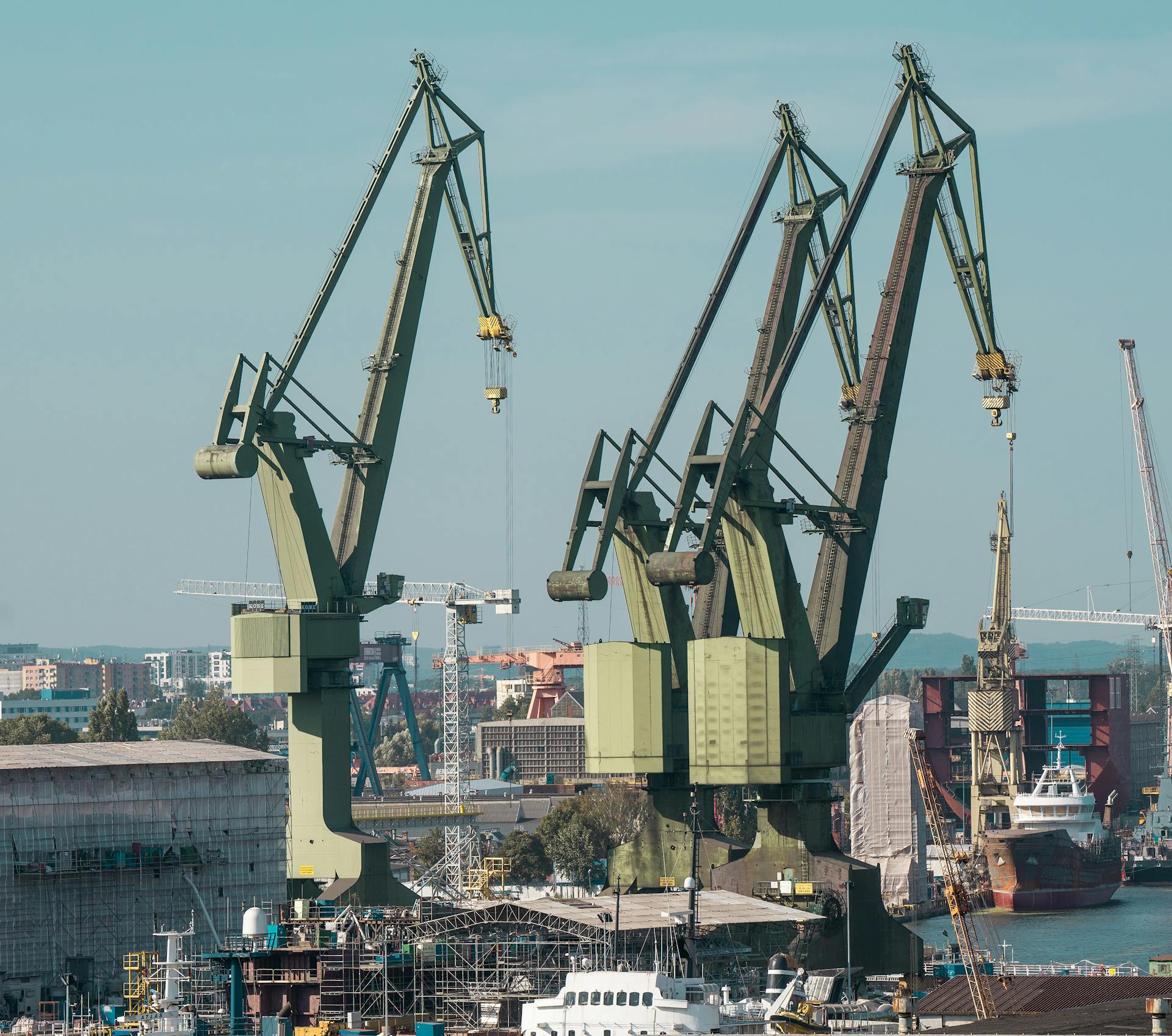
The Base Closure of Mare Island Naval Shipyard was a significant event that had far-reaching consequences for the local community. The shipyard was decommissioned on 31 March 1996, marking the end of its 70-year service.
The facility was transferred to various organizations, including the California Conservation Corps, Touro University California, and numerous commercial and industrial businesses. They are currently leasing property aboard the former naval shipyard.
In 2000, the Navy completed the transfer of a former housing area called Roosevelt Terrace, using an "economic development conveyance" to accelerate the transfer process. This method allowed the Navy to quickly transfer the property to civilian communities for their economic benefit.
The Navy is also transferring property at the shipyard to other government agencies, such as the Fish and Wildlife Service refuge and a Forest Service office building.
Broaden your view: California Shipbuilding Corporation
War Bonds
The workers at Mare Island's military and civilian workforce showed incredible patriotism and teamwork, raising almost $76M in war bonds. This was enough to pay for every one of the submarines built at MINSY prior to VJ Day.
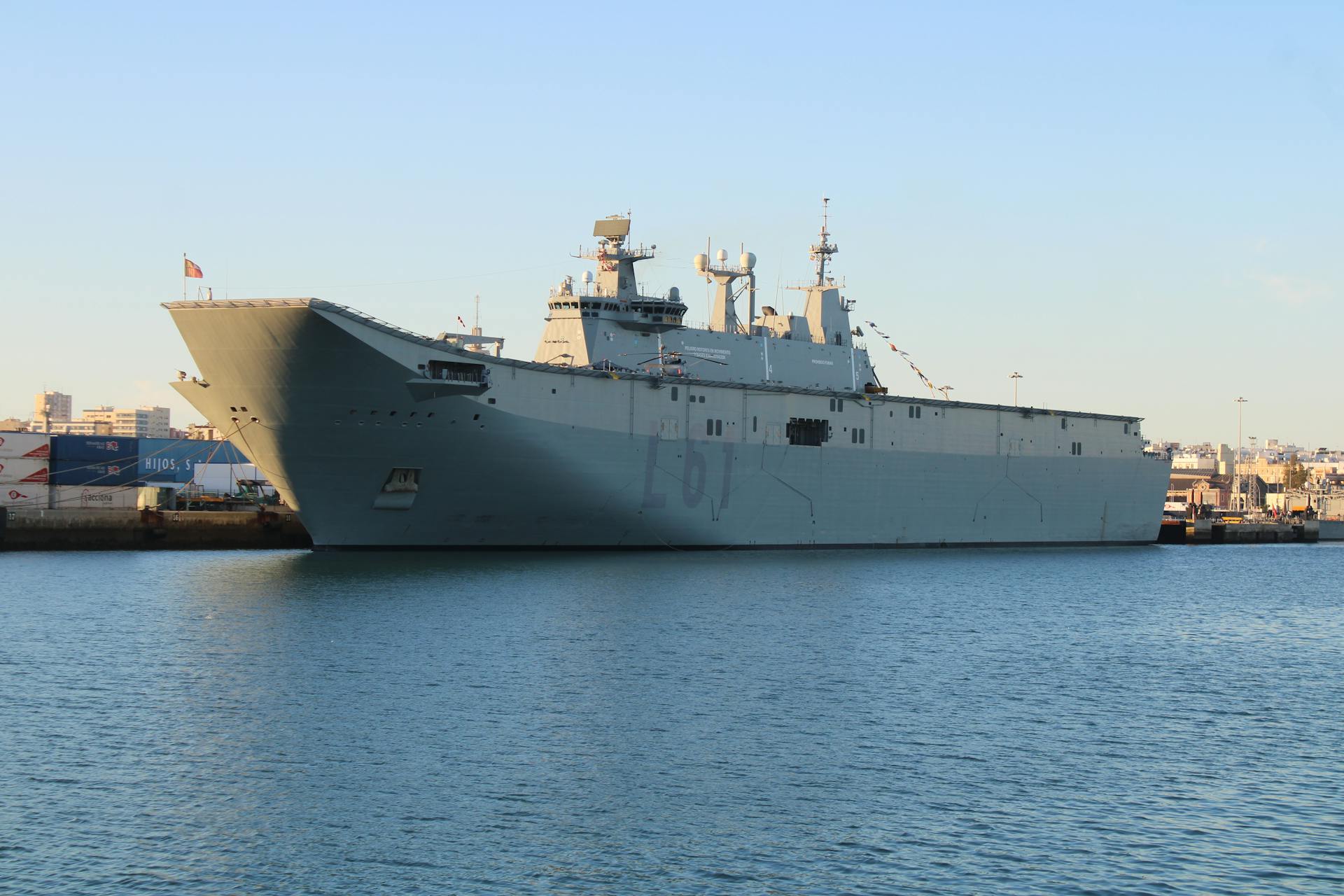
The Mare Island Naval Shipyard played a significant role in supporting the war effort by building over 300 landing craft.
Here are some key statistics about the war bonds raised by the Mare Island workforce:
- Amount raised: almost $76M
- Purpose: to pay for submarines built at MINSY prior to VJ Day
Submarines and Naval History
Mare Island Naval Shipyard played a significant role in the development of submarines. The shipyard built two of the Navy's first submarines, the USS Grampus and the USS Pike.
During World War I, the shipyard increased its production of warships, including the destroyer USS Ward, which was built in under 18 days in 1918. This impressive feat set a speed record for the shipyard.
Mare Island saw its biggest business boom during World War II, producing an impressive array of vessels, including four submarine tenders, thirty-one destroyer escorts, and seventeen submarines.
The shipyard continued to be a major player in submarine production after the war, becoming one of the main shipyards for constructing and repairing the Navy's Pacific fleet of submarines. This was largely due to the many submarines it built during World War II.
Mare Island produced its first nuclear-powered submarine in 1957, marking a significant milestone in the shipyard's history. The shipyard also opened the Nuclear Power School to educate workers in the basics needed to build and work with nuclear-powered submarines.
Here's a breakdown of the submarines built by Mare Island Naval Shipyard during World War II:
- Four submarine tenders
- Thirty-one destroyer escorts
- Seventeen submarines
- Thirty-three small craft ships
- Around 300 landing craft vessels
The shipyard's last submarine, the USS Drum, was built in 1970, marking the end of an era for Mare Island Naval Shipyard.
Frequently Asked Questions
What happened to Mare Island Naval Shipyard?
Mare Island Naval Shipyard was decommissioned and closed in 1996 due to the Base Realignment and Closure (BRAC) process of 1993. Operations ceased on March 31, 1996, marking the end of its naval activities.
Can you visit Mare Island Naval Shipyard?
Yes, Mare Island Naval Shipyard is open for tours by appointment. Visit Mare Island to explore its rich 142-year history and discover the fascinating stories behind its operations.
How many submarines were built at Mare Island?
Forty-four submarines were built at the Mare Island Ship Yard between 1930 and 1970. The yard's submarine production spanned six decades, starting with the USS V-6.
Sources
- https://en.wikipedia.org/wiki/Mare_Island_Naval_Shipyard
- https://uscs.org/resources/exhibits/a-history-of-the-submarines-built-at-mare-island-naval-shipyard/
- https://clui.org/ludb/site/mare-island-naval-shipyard
- https://mesothelioma.net/mare-island-naval-shipyard/
- https://www.engeo.com/our-projects/mare-island-naval-base-shipyard-reuse/
Featured Images: pexels.com

